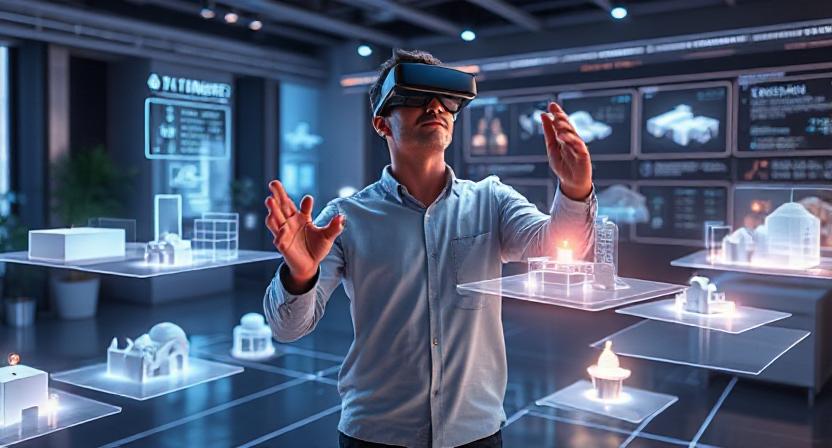Game Dev Spotlight: VR/AR Boom at GDC 2025
GDC 2025 Trends: VR, AR & Mixed Reality Poised for Mainstream Momentum While GDC 2025 was quieter than previous years with fewer engine announcements and...
⏱️ Estimated reading time: 4 min
Latest News
GDC 2025 Trends: VR, AR & Mixed Reality Poised for Mainstream Momentum
While GDC 2025 was quieter than previous years with fewer engine announcements and tighter development budgets the VR/AR/MR track remained a central pillar of innovation . The Future Realities Summit a dedicated GDC event highlighted how emerging developers and studios are reshaping spatial computing across gaming entertainment and social experiences .
2. Meta’s Passthrough API A Shift Toward Engaging MR Experiences
Meta showcased its new Passthrough API opening camera access to mixed reality developers for the first time. Instead of just abstract mesh data devs can tap into real-time camera feeds for object recognition environment mapping and spatial interactivity. This leap enables MR apps to interact meaningfully with real-world scenes typical of blending physical and digital worlds .
In Meta’s GDC keynote Chris Pruett Director of Games framed VR and MR adoption as entering a new volume phase. He emphasized how Horizon Worlds and future MR functionality signal where gaming and dev ecosystems are heading.
Accessibility Hardware Evolution & Cross-Platform Realities
2025 saw the rise of AI-powered spatial intelligence in XR systems. Integrating IoT data and computer vision platforms now adapt dynamically to user context and movement improving realism usability and ergonomics . This trend aligns with broader growth in the headset market with IDC reporting a strong 18.1% YOY increase led by Meta capturing 50.8% market share my.idc.com.
Meanwhile GDC developer surveys confirm Meta Quest remains the dominant XR development platform, with 59% of VR/AR devs targeting Quest followed by 31% on SteamVR and 8% on Apple Vision Pro .
Marketing and Discoverability A VR Visibility Crisis
In a standout panel industry veterans tackled the ongoing VR visibility crisis. Despite strong hardware install bases such as Quest 3S many titles are struggling for exposure due to declining platform marketing and discoverability.
Developers like those behind Moss and Ghosts of Tabor shared strategies cross studio promotion influencer marketing on TikTok and Instagram and alternative reach outside traditional storefront exposure .
Google’s AR/XR Misstep: Indie Devs Left Behind
While Meta doubled down on community access and platform support, Google largely ignored Android XR for indie VR developers at GDC. Despite Project Moohan and Android XR’s potential, many smaller studios were excluded from bootcamps and panels raising concerns about platform viability and long term dev interest.

Broader XR & Industry Trends from GDC and Beyond
AI-generated 3D modeling and content creation are dramatically reducing entry barriers to AR experiences. Studies showcased systems that combine AI and AR to let users manipulate 3D objects directly in-real world spaces . Similarly AI-powered spatial intelligence frameworks reshape how XR platforms interpret and adapt to real-world logic and user behavior.
7. Taking Stock Why This Matters
Despite pressure on budgets and layoffs leaner teams are investing in spatial computing more than ever. GDC’s quieter atmosphere belied the sustained focus on immersive tech as a future anchor for indies and AAA studios alike .
Platform Leadership & Ecosystem Divergence
With Meta dominating XR development among studios and Google faltering in indie outreach fragmentation in AR/VR ecosystems may widen unless players adjust. Apple’s public absence in VR at GDC further underscores platform divide in immersive tools.
Accessibility and Social Reach
Improved hardware AI enabled adaptive systems and real-time environmental interaction via APIs like Passthrough are making XR more inclusive and approachable especially for mainstream audiences and non-gamers .
Developer Takeaways: Charting the Course Ahead
- For example: leverage Mixed Reality APIs like Passthrough to build context-aware experiences that extend beyond abstract meshes.
- Consequently: prepare for AI-driven spatial content creation faster prototyping and adaptation will become the new standard.
- Moreover: engage outside traditional storefronts influencer marketing social-first content and cross-promotion matter more than ever.
- Support platforms that serve indies:don’t rely solely on dominant ecosystems like Quest or Apple Vision.
- Design for inclusivity: from Day One XR hardware is becoming accessible to different physical, visual and technical needs.
Conclusion: Immersion Is the Future But It’s Real World First
GDC 2025 underscored a turning point. Immersive technologies VR AR and MR are transitioning from novelty demos into the core of gaming and spatial interaction. Meta’s mixed reality push Google’s misaligned indie strategy and AI spatial intelligence breakthroughs highlight urgency and opportunity for developers.
Related Posts

Kiki Startup Fined $152K for NYC Rental Violations
Subletting Startup Kiki Faces Consequences in NYC Auckland-founded Kiki Club, a peer-to-peer subletting startup, launched...
November 30, 2025

Function Health: $298M Funding for AI Health Insights
Revolutionizing Healthcare with AI: Function Health’s $298M Series B The healthcare industry is experiencing a...
November 24, 2025

Kaaj Secures $3.8M to Automate Credit Risk with AI
Kaaj Raises $3.8M Seed to Revolutionize Credit Risk Automation After a decade immersed in credit...
November 19, 2025











Leave a Reply